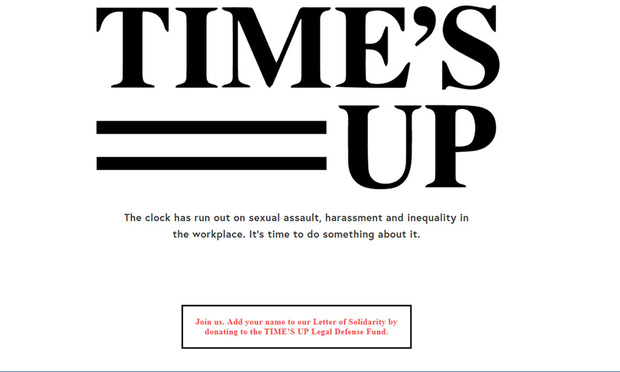Robbie Kaplan: #TimesUp on Gender Inequality in the Legal Profession
Roberta Kaplan, who recently left Big Law to start her own litigation boutique, takes aim at the findings highlighted in a recent article by The American Lawyer on male clients disfavoring working with female lawyers.
February 06, 2018 at 11:31 AM
4 minute read

As a girl growing up in Cleveland, Ohio, I loved to talk. When I was three years old, for example, my mother, in a letter to her younger brother who was then serving in the Peace Corps in India, wrote: “You have to converse with her to appreciate it… if she lets you get a word in, that is.” Another letter from my Grandma Belle recounts: “I asked her to please stop talking for fifteen minutes,” to which I apparently responded: “I really can't Grandma, I'm a big talker.” I wanted to become a lawyer because I had heard somewhere that lawyers actually got paid to talk a lot.
That's why it was so disheartening to read an article in American Lawyer titled “Male Clients Disfavor Women Partners.” The article notes that “male clients are choosing women to lead their work at a rate that's even below the national percentage of female equity partners,” which is 19 percent. This is despite the fact, as the author aptly notes, that research shows “mixed gender teams significantly outperform single-sex teams on all industry-recognized key performance indicators.”
What is even more disheartening (not to mention exhausting) is that it feels like we keep having the very same conversation over and over again. Reading this article made me feel like I was the Bill Murray character in some bizarre, anti-feminist version of the movie “Groundhog Day.” In fact, in 1988—the year I graduated from college—none other than Hillary Clinton served as the inaugural chair of the American Bar Association Commission on Women in the Profession. In that position, she released a then-groundbreaking report documenting the lack of advancement opportunities for female lawyers.
But thirty years later, and despite the fact that women make up more than 50 percent of law school graduates (and have for years), not much has changed. The statistics paint a bleak portrait of our profession: according to a recent report by the New York State Bar Association, women represent only 25 percent of lead counsel roles in all types of cases. The most striking disparity appears in complex commercial cases: women's representation as lead counsel shrinks from 31 percent in one-party cases to 26 percent in two-party cases to just 19 percent in cases involving five or more parties. In other words, at every level and every court—federal and state, trial and appellate, criminal and civil—it is clear that women are not getting the chance to talk.
The problem here is one of access, not substance. Clients are best served by lawyers who will fight on their behalf, regardless of how they look, love or pray. The best lawyers really listen to what their clients have to say, take their clients' issues to heart, and then help to solve their clients' problems in creative and efficient ways. These, of course, are not gender-specific qualities.
At Kaplan & Company, we defend companies like T-Mobile and Airbnb, and we defend clients like Melanie Kohler, the woman sued by Hollywood producer Brett Ratner for defamation. We sue counterparties in connection with complicated real estate ventures, and we sue the Nazis and white supremacists responsible for the violence in Charlottesville. And the gender, ethnicity, or religion of our lawyers makes zero difference to the skills, commitment and work product we bring to the table.
In her new book, “Women & Power: A Manifesto,” the eminent classical scholar Mary Beard observes that the “mechanisms that silence women, that refuse to take them seriously and that sever them … from the centres of power” are “deeply embedded” in Western culture. But even though it's very clear how deeply these attitudes are entrenched, we cannot be like Bill Murray, still having this very same conversation 30 years from now. Time is, quite literally, up. As per usual, my Grandma Belle was 100 percent correct—there is nothing wrong with being a girl who really, really likes to talk. Time's Up.
Robbie Kaplan can be followed on Twitter @kaplanrobbie.
This content has been archived. It is available through our partners, LexisNexis® and Bloomberg Law.
To view this content, please continue to their sites.
Not a Lexis Subscriber?
Subscribe Now
Not a Bloomberg Law Subscriber?
Subscribe Now
NOT FOR REPRINT
© 2025 ALM Global, LLC, All Rights Reserved. Request academic re-use from www.copyright.com. All other uses, submit a request to [email protected]. For more information visit Asset & Logo Licensing.
You Might Like
View All

No 'Gray Area' In Lawyers' Oversight of Investigators, Commentator Argues
Trending Stories
Who Got The Work
J. Brugh Lower of Gibbons has entered an appearance for industrial equipment supplier Devco Corporation in a pending trademark infringement lawsuit. The suit, accusing the defendant of selling knock-off Graco products, was filed Dec. 18 in New Jersey District Court by Rivkin Radler on behalf of Graco Inc. and Graco Minnesota. The case, assigned to U.S. District Judge Zahid N. Quraishi, is 3:24-cv-11294, Graco Inc. et al v. Devco Corporation.
Who Got The Work
Rebecca Maller-Stein and Kent A. Yalowitz of Arnold & Porter Kaye Scholer have entered their appearances for Hanaco Venture Capital and its executives, Lior Prosor and David Frankel, in a pending securities lawsuit. The action, filed on Dec. 24 in New York Southern District Court by Zell, Aron & Co. on behalf of Goldeneye Advisors, accuses the defendants of negligently and fraudulently managing the plaintiff's $1 million investment. The case, assigned to U.S. District Judge Vernon S. Broderick, is 1:24-cv-09918, Goldeneye Advisors, LLC v. Hanaco Venture Capital, Ltd. et al.
Who Got The Work
Attorneys from A&O Shearman has stepped in as defense counsel for Toronto-Dominion Bank and other defendants in a pending securities class action. The suit, filed Dec. 11 in New York Southern District Court by Bleichmar Fonti & Auld, accuses the defendants of concealing the bank's 'pervasive' deficiencies in regards to its compliance with the Bank Secrecy Act and the quality of its anti-money laundering controls. The case, assigned to U.S. District Judge Arun Subramanian, is 1:24-cv-09445, Gonzalez v. The Toronto-Dominion Bank et al.
Who Got The Work
Crown Castle International, a Pennsylvania company providing shared communications infrastructure, has turned to Luke D. Wolf of Gordon Rees Scully Mansukhani to fend off a pending breach-of-contract lawsuit. The court action, filed Nov. 25 in Michigan Eastern District Court by Hooper Hathaway PC on behalf of The Town Residences LLC, accuses Crown Castle of failing to transfer approximately $30,000 in utility payments from T-Mobile in breach of a roof-top lease and assignment agreement. The case, assigned to U.S. District Judge Susan K. Declercq, is 2:24-cv-13131, The Town Residences LLC v. T-Mobile US, Inc. et al.
Who Got The Work
Wilfred P. Coronato and Daniel M. Schwartz of McCarter & English have stepped in as defense counsel to Electrolux Home Products Inc. in a pending product liability lawsuit. The court action, filed Nov. 26 in New York Eastern District Court by Poulos Lopiccolo PC and Nagel Rice LLP on behalf of David Stern, alleges that the defendant's refrigerators’ drawers and shelving repeatedly break and fall apart within months after purchase. The case, assigned to U.S. District Judge Joan M. Azrack, is 2:24-cv-08204, Stern v. Electrolux Home Products, Inc.
Featured Firms
Law Offices of Gary Martin Hays & Associates, P.C.
(470) 294-1674
Law Offices of Mark E. Salomone
(857) 444-6468
Smith & Hassler
(713) 739-1250












